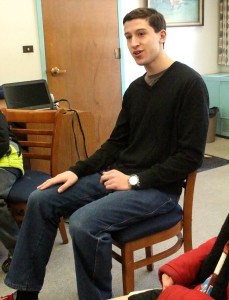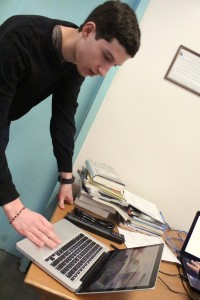Photo: Jack Stone showing elementary age students is app for the classroom.
By Mengjia Xu
Wearing a black T-shirt and white pants, Jack Stone – who graduated from Belmont High School in June – is both informal and approachable, just like the apps he creates.
(An app is a software program that’s designed to perform a specific function directly for the user, such as a map, games or reviewing when the next MBTA bus will arrive at your stop).
During his time at Belmont High, Stone started the school’s first computer club and helped write the curriculum for the coding course currently being offered.
Though the school does not necessarily have to teach specific programming languages, “the underline principles of computer science rather than programming” would be beneficial to students “in all facets of life,” he said.
Stone believes high school students should have a background in computer science and the Belmont School District should establish more courses in this field in both the middle and high schools to reach this goal.
“It’s the most efficient way of solving problems,” arguing that computer science is a different way of critical thinking that can be applied in all fields of learning.
Jack’s interest in programming traces back to eighth grade at the Chenery Middle School when he created his first computer games. While he loved computer games, Stone realized he did not just want to “use someone else’s work,” but to “create [his] own.”

Jack Stone.
Creating apps blends Jack’s favorite things about programming because he likes to do everything: write the frontend and backend, design interface, marketing and packaging. Inspirations sometimes stream through Jack’s mind when he’s “sitting on a couch.”
Once he starts working on a project, he dives through the process on his own. An app usually takes a week or two to create, followed by a lot of revisions as he relies on his friends’ feedback.
Some of Stone’s apps include a physics equations solver and a JavaScript screen recorder, each sharing features of practical convenience and easy use, with polished interfaces and functionality.
“What I strive to do with my projects is to improve people’s lives,” said Stone.
Growing up with parents not versed in programming, Jack picked up programming online and through books, integrating theory with practice.
As a self-taught programmer, he sometimes struggles when confronted with technical difficulties, and Google search is his first and only way to get help. Since Belmont does not offer AP Computer Science, it is hard to find a programming expert, be they teacher or student, to consult.

Jack Stone.
To gain more practical experience in computer work, Stone is taking a “gap” year to intern at a software firm before attending Harvard College in the fall of 2016.
For Stone, the coming year will be a chance to “get a break from working incredibly hard in the past four years.” It will also give him an opportunity to focus on music and traveling. A nationally-recognized bass trombonist, Stone is seeking to improve his playing before auditioning for Harvard’s orchestra.
Devoting a year to explore his interests will not only boost his competitiveness in college, but also lay the foundation for a future career. Working at software companies will allow him to gain real-world experiences such as writing code for collaborative projects and establishing interpersonal networks.
Stone hopes to gain “fresh perspectives” that can help him to develop his new software that “simplifies the sharing of information between people.”


